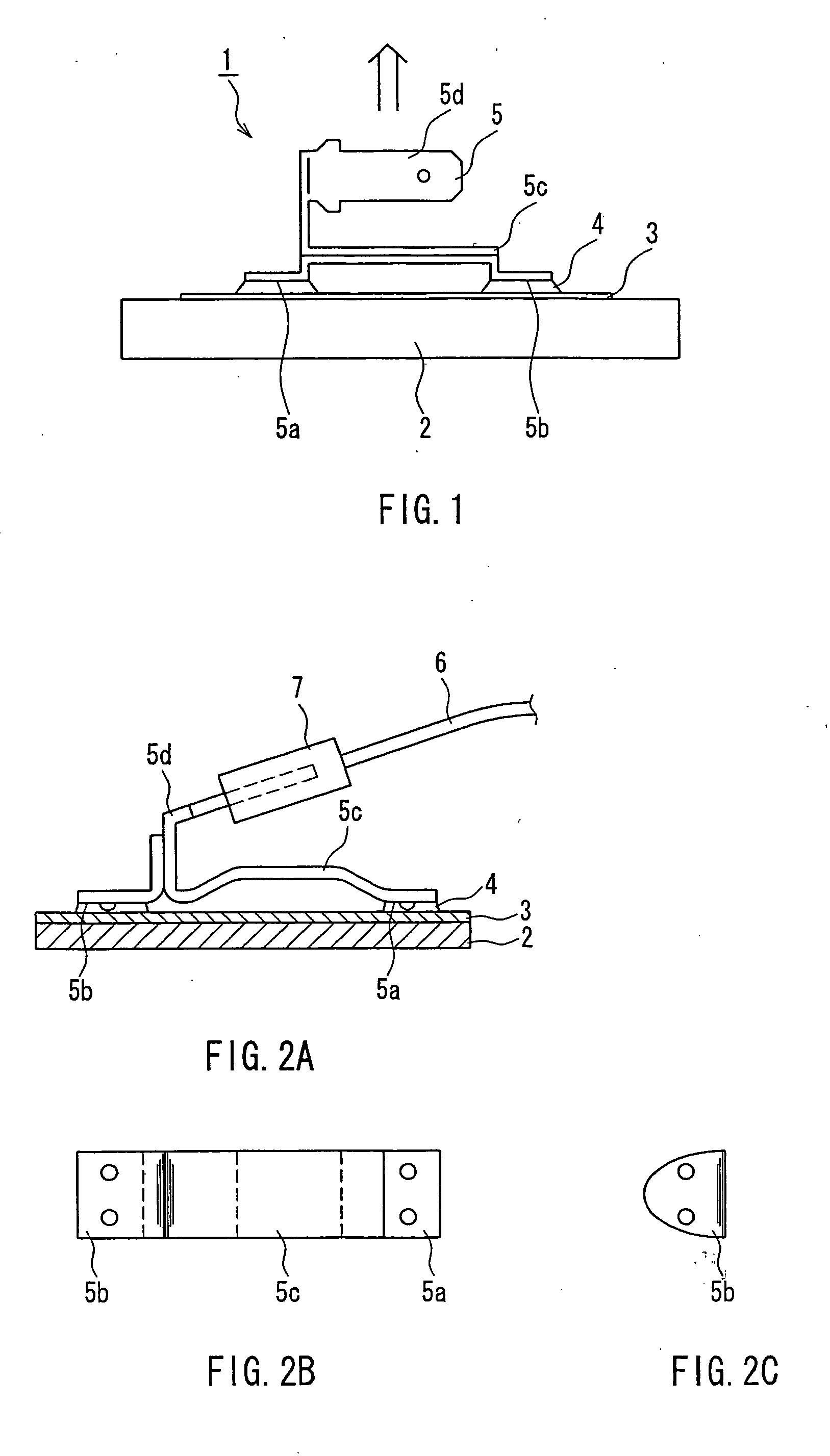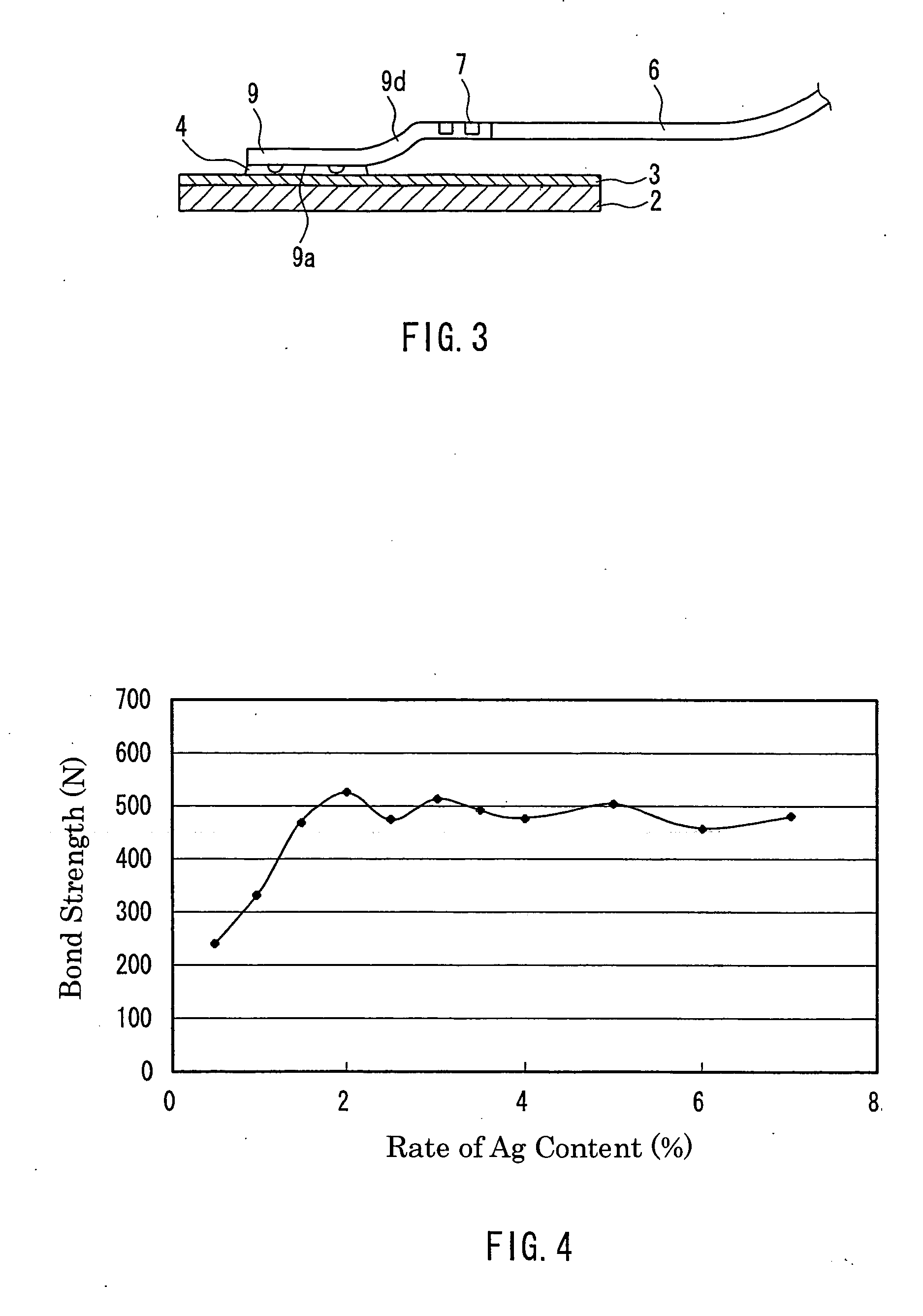Glass fixture-joined glass article and joint structure using this
a glass fixture and glass article technology, applied in the field of glass articles, can solve the problems of cracks at the surface of glass sheets, difficult to ensure the bond strength of metal terminals, and affect the appearance of electroconductive coating films, so as to improve the bond strength and not only the appearance
- Summary
- Abstract
- Description
- Claims
- Application Information
AI Technical Summary
Benefits of technology
Problems solved by technology
Method used
Image
Examples
example 1
[0035] The same junction structures as that shown in FIG. 1 were produced. In each of them, soda-lime silica glass having a thickness of 3.1 mm was used for the glass sheet 2, a Sn—Ag alloy whose Ag content is shown in Table 1 was used as the lead-free solder alloy 4, and a terminal formed of a Cu metal sheet was used as the metal terminal 5. The areas of the two joining planes of the metal terminal 5 are set to be equal (a ratio of 1:1) to each other and to sum up to 56 mm2. The electroconductive coating film 3 was formed by screen-printing an Ag paste containing about 80 mass % of Ag particles, about 5 mass % of a glass frit, and about 15 mass % of an organic solvent, drying it, and further baking it at about 700° C.
[0036] The lead-free solder alloy was applied to the joining planes of the metal terminal beforehand. The soldering was carried out by applying a flux to the solder alloy, pressing the joining planes of the metal terminal onto the electroconductive coating film, and p...
example 2
[0041] Samples were obtained in the same manner as in Example 1 except that a Sn—Ag alloy was used that contains 98 mass % of Sn and 2 mass % of Ag, and the total area of the joining planes was set at the values shown in Table 2.
[0042] With respect to each sample thus obtained, its bond strength was measured in the same manner as in Example 1. The results are shown in Table 2.
[0043] In all the samples, rupture of the junction took place not at the soldered junction but inside the glass.
TABLE 2Total Area ofJoining PlanesBond StrengthSamples(mm2)(N)2A28522.32B35519.52C42727.92D49591.82E56503.1
[0044] As is apparent from FIG. 5 showing the relationship between the total area of joining planes (joining area) and the bond strength, the bond strength degrades both in the case where the joining area is too large and where it is too small. Thus, in order to improve the bond strength in the junction structure in which the terminal having a plurality of joining planes is fixed with a “hard...
example 3
[0045] Samples were obtained in the same manner as in Example 1 except that the amount of the lead-free solder alloy 4 provided on the respective joining planes and the total area of the joining planes were set at values shown in Table 3. With respect to each of n pieces of samples thus obtained, a thermal test was carried out through predetermined temperature cycling, and the state of the glass surface was checked visually every 100 cycles after 200 cycles. The temperature cycling was set to include a period of retention for 30 minutes at −30° C., a period of raising temperature to 80° C. in three minutes, a period of retention in this state for 30 minutes, and a period of decreasing temperature to −30° C. in three minutes, and thus the thermal cycle test was carried out. The results are shown in Table 3.
[0046] In Samples 3A to 3D and 3F to 3G, no cracks occurred in the glass even when the above-mentioned thermal cycle was repeated 500 times. In Sample 3A, the bond strength determ...
PUM
| Property | Measurement | Unit |
|---|---|---|
| Percent by mass | aaaaa | aaaaa |
| Percent by mass | aaaaa | aaaaa |
| Percent by mass | aaaaa | aaaaa |
Abstract
Description
Claims
Application Information
 Login to View More
Login to View More - R&D
- Intellectual Property
- Life Sciences
- Materials
- Tech Scout
- Unparalleled Data Quality
- Higher Quality Content
- 60% Fewer Hallucinations
Browse by: Latest US Patents, China's latest patents, Technical Efficacy Thesaurus, Application Domain, Technology Topic, Popular Technical Reports.
© 2025 PatSnap. All rights reserved.Legal|Privacy policy|Modern Slavery Act Transparency Statement|Sitemap|About US| Contact US: help@patsnap.com



